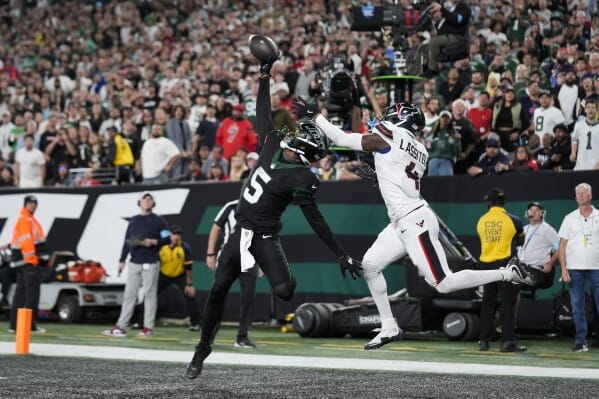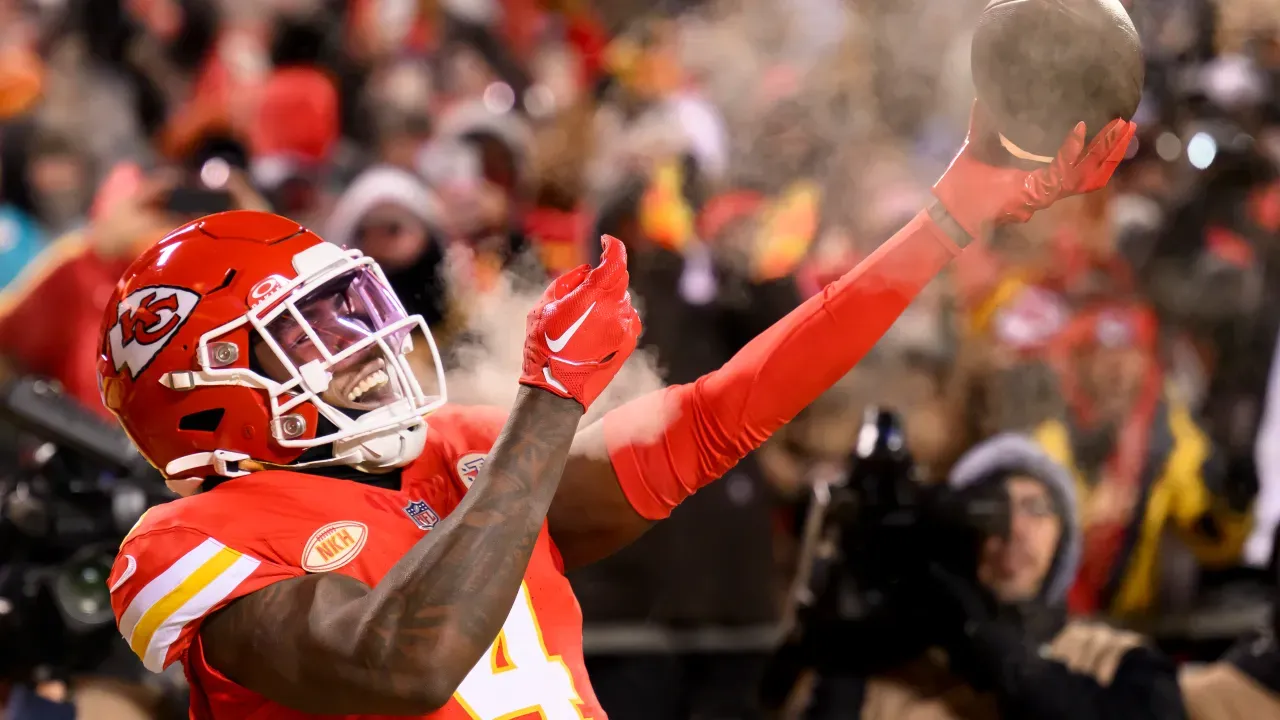
Dynasty Value—Blue Skyys for Rashee Rice
Introducing Stephanie Miller
If you read Stephanie Miller's FAABulous Football newsletter this past season, you likely had a very strong year on the waiver wire. You're also aware that Steph is exceptional at parsing the chaos the NFL throws at us and identifying player targets. In addition to bringing her waiver wire column to LegUp this season, Steph is contributing to our dynasty rankings and providing dynasty analysis. This debut piece should make it abundantly clear how valuable that will be for LegUp subscribers.
-Pat
Dynasty Value––Blue Skyys for Rashee Rice
I’m old enough to remember when March was reserved for serious fantasy football players … dynasty players. It was a much simpler time, where you were hardcore just for doing a dynasty startup or rookie draft. The casual players were those who only did redraft leagues.
Most dynasty players have a limit on how many leagues they can join because of the in-season management aspect. Because of these limitations, most dynasty players collect information on market value and ADP from a relatively small sample of startups and rookie drafts. If drafters are to obtain a larger sample, it is with the prevalent use of fake mock drafts, most of which are free... and not very realistic, if we are being honest.
Fast-forward to 2024, where early redraft-style best ball tournaments have created a new class of fantasy players. These drafters are well versed in rookies metrics, watch the Combine to analyze athleticism, and intently track every free agent move teams make–not to mention spending countless hours studying and debating optimal draft strategies, roster construction, and how much Week 17 matters.
These best ball players are the new evolution of hardcore fantasy players. Many of these drafting degenerates have already completed 100+ Big Board drafts before the NFL Draft has even begun–no judgment, the call is coming from inside the house.
This got me thinking. Early best ball drafters who willingly have real skin in the game, with money on the line, are most likely more dialed in than the average dynasty player participating in free mock drafts and only a handful of leagues. Not to mention that there are likely very few casual players drafting in a contest that ends before the real NFL Draft even begins.
Jack Miller found evidence when Investigating the Power of the Market in Best Ball Mania that ADP was an efficient market and a "very strong predictor of fantasy points" on Underdog’s BBM contest. It only stands to reason that using sharp ADP from an active population to evaluate the dynasty market value could be an exploitable edge.
Leveraging Big Board ADP for Dynasty Market Value
When I looked at the 2024 Big Board ADP on Underdog and the current dynasty market value on players, one player immediately stood out to me: Rashee Rice.
Dynasty has more nuance than best ball, incorporating additional factors–like age and predictions on when an asset will gain or lose value. However, in most cases, youth is marked up to a premium price because of the opportunity for multiple seasons of top 24 WR finishes throughout a player's career–assuming they are an ascending talent on an upward trajectory to rise in value.
The ultimate name of the game is to correctly predict and identify which players finish as top fantasy producers before the breakout occurs, and get off a player before we see a decline in production and they lose value.
But those factors are baked into the the LegUp Dynasty Rankings... which are substantially ahead of the market on Rice as well.

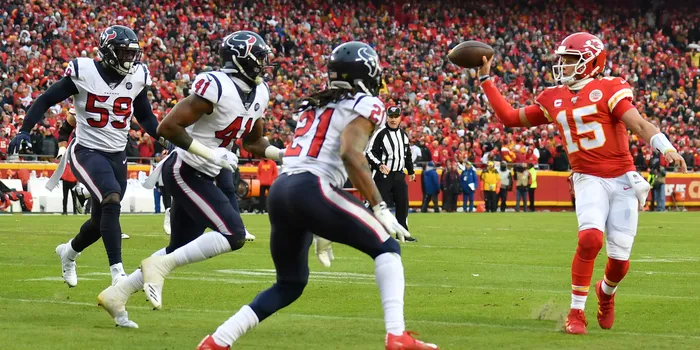
When we look at the ADP value of a second-year player in the best ball market that is being valued as a high-end asset, such as Rice, there is actually more risk in the best ball format if the player doesn’t immediately pay off their price, because you are only paying for this season. I would argue there is more room to be patient in a dynasty format if said prediction takes an extra season or the breakout is a smaller step than initially predicted...because you still get to keep that player for the longevity of their career.
Of course there is a downside risk in dynasty that is absent from redraft. If you invest heavily in a career bust, then you are stuck with that player dying on your roster or forced to trade a once highly coveted asset for pennies on the dollar.
Basically, this is a long-winded explanation for me saying if anything, Rashee Rice should be more expensive in dynasty formats, not less expensive. The ability to be close to even with the best ball market and stay ahead of the current dynasty market value feels like a huge win. This win is amplified to an even greater extent when we weigh in the likelihood that Rice is a prime candidate for a second-year breakout.
Identifying Second-Year Breakout Wide Receivers
Here I examine WR data from 2011-2022 to understand when in a player’s career arc WR1 and WR2 breakout seasons typically occur and what types of identifying signals typically precede breakouts. The results from Dwain McFarland’s research in Fantasy Football’s Breakout Wide Receivers found most top 36 fantasy seasons occur by the second year, while most top 24 WR fantasy performances occur by the third year.
The evidence overwhelmingly suggests the best predictor of future success is past success; 78% of first-time breakout WR1 finishes flashed a WR2 or WR3 fantasy season, and 51% of first-time breakout WR2 finishes had a WR3 fantasy season previously.
Additionally, there are specific talent markers associated with WR1, WR2, and WR3 level talent profiles that serve to further increase the hit rate of identifying future breakouts. These guidelines were especially predictive for WRs that failed to have a WR3 level of success prior to their breakout, identifying 93% of WR1 breakouts who did not have a top 36 season on their resume. This additional metric criteria also increased the hit rate of identifying breakout WR2 players to 80%.
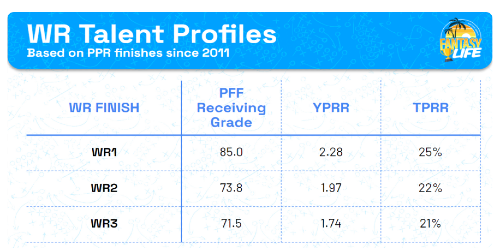
When applying this data to Rashee Rice’s rookie season, his WR breakout potential becomes abundantly clear.
Rice played in 16 games during the regular season, catching 79 of 103 targets, 938 receiving yards, and seven receiving TDs—finishing as the WR27 in PPR scoring his rookie year.
Per the chart above, Rice also met the criteria to finish on par with a WR1/WR2 level talent profile. Including the playoffs, Rice earned an elite 86.1 PFF receiving grade with an excellent 2.21 YPRR, finishing as the WR14 and WR15, respectively. He also saw an impressive 28% TPRR, finishing as the WR13 amongst all qualified WRs with a minimum of 35 targets and 50 routes.
These numbers look even more impressive when compared to the rest of the 2023 rookie WR class. Rice finished with the 4th most PPR points among his rookie colleagues but outperformed all other rookies in talent profile metrics... with the exception of rookie sensation Puka Nacua. Rice did actually tie Nacua as the rookie WR1 in PFF receiving grade but finished behind Nacua as the rookie WR2 in both YPRR and TPRR.
Like Nacua, Rice had some red flags in his prospect profile while also flashing in YPRR. In his fourth and final season at SMU, he paired a 32% receiver dominator with an elite 3.05 YPRR. He wasn't quite at Nacua's ridiculous level (3.53), but after earning Round 2 draft capital, Rice followed up that season with an elite 2.21 YPRR. That should get our attention.
The Whole Rookie Story
Rashee Rice flashed top 24 breakout indicators in 2023, but that doesn't tell the full story of his rookie season.
I used RotoViz’s NFL Stat Explorer tool to provide a visual of Rice’s PPR point distribution from Week 1-17 during the regular season.

A quick glance at this graph and it is easy to see that Rice saw a huge spike in fantasy scoring during the second half of his rookie season. Rice began the season with no WR1 performances and only two WR2 weeks. He only scored 15+ PPR points once and never reached 20 PPR fantasy points during this time span.
After the Chiefs' Week 10 bye, Rice’s production took off like a rocket ship, with three top 12 performances of 20+ PPR points and an additional two top 24 fantasy weeks. In fact, Rice had only one week during this time period where he failed to reach double digit fantasy points.
Rice averaged 13.4 PPR points per game for the season but if we only look at games after his Week 10 bye, that increases to 17.3. To put that number in perspective, that would have ranked WR5 in PPR points per game last season and second highest among rookie WRs– again barely trailing Puka Nacua, who finished with 17.6 points per game.
Legendary Upside's own statistical guru, Sackreligious, also uncovered a bullish nugget on Rice when using Sortino ratio to look at rookie WR performances from the first to the second half of the season.
To recap, Sortino ratio is a way to quantify a player’s floor/ceiling combination. While Sack analyzes this from mostly a best ball perspective, in a managed format, the consistency of a high floor and ceiling combo is highly desirable when a manager must decide who to start every week.
I am ecstatic to report that Rice had the largest increase from first to second half in Sortino percentile differences, finishing in the 100th percentile–I’m gonna go out on a limb and assume that is pretty damn good.
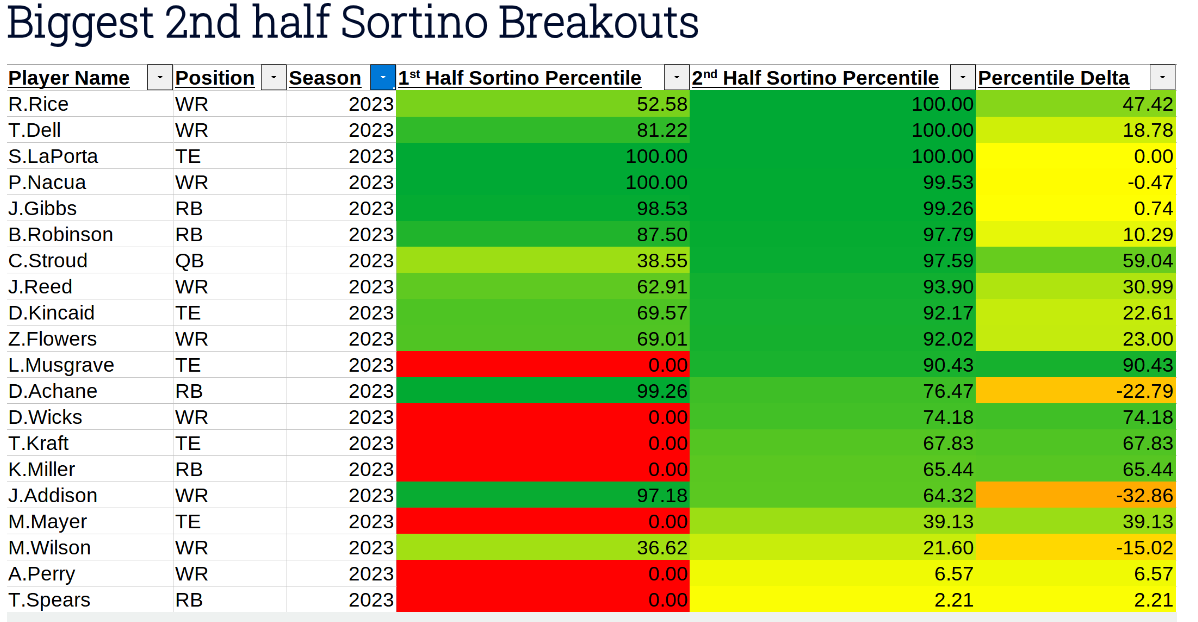
For a deep dive into the Sortino ratio I highly recommend checking out Sack’s insightful article.
Given that Rice was a rookie, some of this increase is typical and expected, as we know from the previous findings from Michael Dubner and Jack Miller.
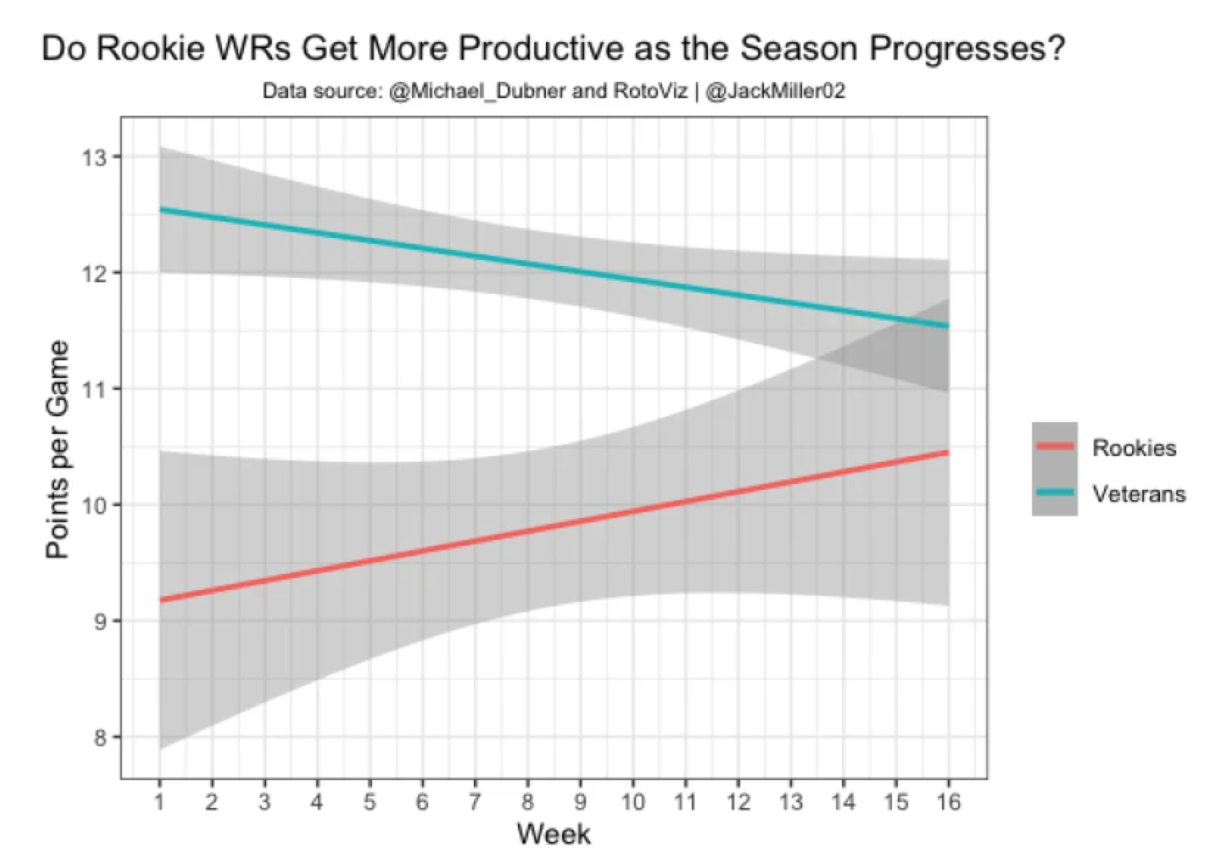
But it's still exciting to see how strong Rice's second half was. At the very least, his impressive production should help him maintain his late-season usage. His Sortino ratio also underlines that despite a slow start, Rice did eventually earn a very strong role in the Chiefs offense.
If we look at Rice’s usage, we see his route numbers fluctuate during the first half of his rookie season. He ran 20 or more routes only four times from weeks 1- 9. I vividly recall peak frustration among Rice drafters after the week 10 bye, where Rice continued to run 25-26 routes for the next three weeks.
Finally, we saw a substantial uptick in use from weeks 14-16, where his route numbers were 37, 32, and 42. In week 17 he dropped back down to running only 28 routes... but did have 127 yds–by far the most of any of his games during the 2023 season… so I guess he didn’t need any more routes that week.
Rice also saw a large increase in the Chiefs' target market share where he had a seasonal average of 18%. If we look at the last six games of the regular season, that usage rises to 27.3%...and Rice handled all that additional volume impressively.
The chart below breaks down Rice’s positional ranks in several volume and efficiency metrics.
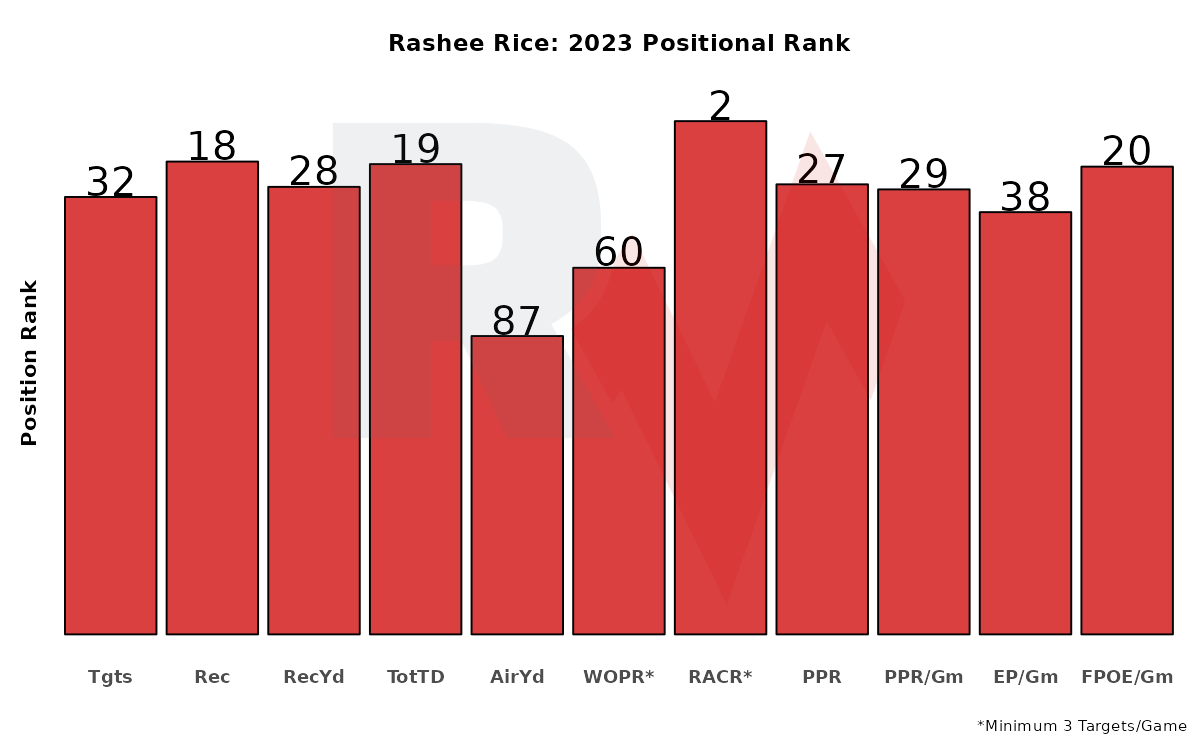
Blue Skyys Ahead
So what can we expect next year? The more stability in a player’s situation, the easier it is to predict how the next season will play out.
In Rice’s case, he is locked into playing on a back-to-back Super Bowl championship team with one of the most talented QBs and best offensive-minded coaches in the NFL for at least the remainder of his rookie contract.
Given his extremely limited role early last season, we can expect Rice's end-of-season usage to be more indicative of his sophomore-year route participation—partially because Rice can be used in a variety of ways. Last year, Rice showed the versatility to play across the formation, seeing almost equal usage in the slot (49.8%) and out wide (49.3%). Keep in mind he achieved this role versatility in what has been described as one of the more difficult and complex offensive systems for rookie receivers to learn.
In short, I see several paths for Rice to grow as a real life player and fantasy asset in future seasons.
However, is this the right time to buy?
Fundamentally, if we've identified an undervalued dynasty target with a high-end ceiling... it's always time to buy. But the Chiefs' signing of Marquise Brown opens up an especially appealing buying opportunity.
Raise your hand if you thought the Chiefs wouldn't add a single WR in free agency or the draft… I'm not seeing any hands. Because, as any reasonable person who follows the NFL would, you assumed the Chiefs would bring in WR help after deeply uninspiring seasons from their non-Rice WRs.
I know you know it was bad, but it's worth revisiting just how bad it was. Rice ranked WR14 out of 212 in PFF receiving grade last year. Pretty good. Calling his teammates' performance abysmal would be an understatement.
- Kadarius Toney (62.9) #101
- Justin Watson (61.6) #109
- Richie James (56.0) #153
- Skyy Moore (54.9) #160
- MVS (52.9) #175
- Justyn Ross (51.0) #192
And here's the craziest thing: despite having a laughably horrific hodgepodge of nobodies at wide receiver, the Chiefs did not change their identity as a pass-first offense.
The Chiefs were the fourth-highest passing team (66.8%) and led the league with a 7.4% PROE– meaning they were choosing to pass. Remember, we are talking about the Super Bowl Champions; they were not forced into an overabundance of trailing game scripts.
But the Chiefs' inefficient WRs did take a toll, severely limiting their ability to attack deep. Per RotoViz’s AYA APP, Patrick Mahomes's deep sideline efficiency dropped off dramatically last year.
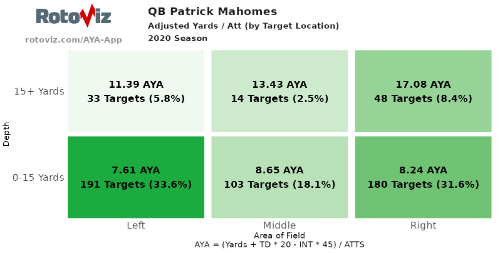
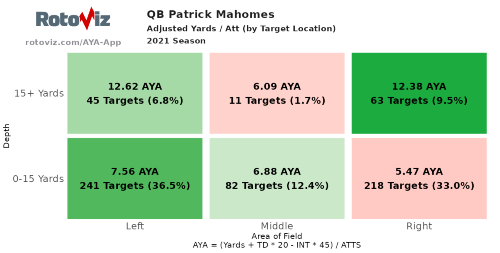
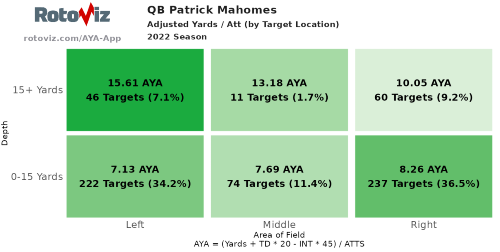
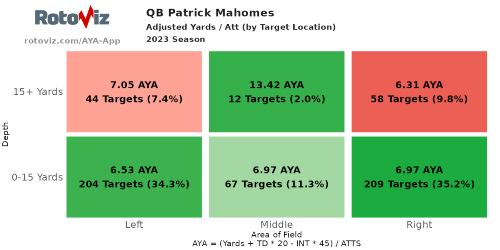
Looking at these maps it is glaringly obvious to see the deep efficiency 15+ yards downfield and along the sideline was a huge problem in 2023–and it wasn’t for a lack of effort on Mahomes’s part.
Seems like they could use a legit outside deep threat.
Throughout his career, Hollywood Brown has profiled as a speedy vertical threat but has struggled to stay healthy and shown some disappointing efficiency numbers in recent years. It's likely that poor QB play is at least partly to blame for that decline. Obviously, Mahomes is a huge upgrade, so if Brown can stay healthy and recapture some of his early career efficiency, he will fill one of the largest and most obvious holes in the Chiefs' offense this year.
So the question is, how does this signing affect Rice?
First, Hollywood is not the same type of receiver as Rice; he is going to operate in a different part of the field. The Chiefs need a true vertical threat to take the top off defenses… this should help open up more room for Rashee Rice and Travis Kelce to operate underneath, and we saw Kelce play a career low on offense, which the Chiefs even admitted was in part to keep him fresh for playoffs and durable the remainder of his days. There is some contingent upside with Rice if Kelce's regular season usage continues to decline or if he has an injury, and this value is not priced into Rice's ADP.
Even if Rice loses some targets because Mahomes can find more success with his deep ball and throws more to Hollywood, this bodes well for the efficiency of the Chiefs’ offense as a whole. This is a situation where we could easily see a substantial increase in total yardage revert back closer to 2022 numbers, where Mahomes threw for over 5,000 yards–ultimately, there would be a much bigger pie to go around, allowing everyone to eat.
The Chiefs signing of Brown is less of a red flag and more of an opportunity to buy.
But what if you have an especially stubborn league mate who's not ready to part with Rice?
At that point, we can let the NFL draft play out. The market loves reacting to news, even if it is something we all should be expecting to happen. Rice’s price is likely to fall as the Brown signing sinks in and will possibly fall again if the Chiefs take a WR early in the draft. So while Rashee Rice is currently one hell of a deal, there is a decent likelihood he will soon become an even better dynasty value.
But given the upside that his profile provides, I don't want to wait until after the draft to acquire Rice if I don't have to. At some point, it should occur to your league mates that Rice posted elite rookie efficiency in a Patrick Mahomes offense whose veteran target competition in Brown (one-year prove-it deal) and Kelce (retirement risk) could both be gone by the end of the year. Regardless of how the Chiefs play the draft, we're looking at blue Skyys ahead for Rashee Rice.
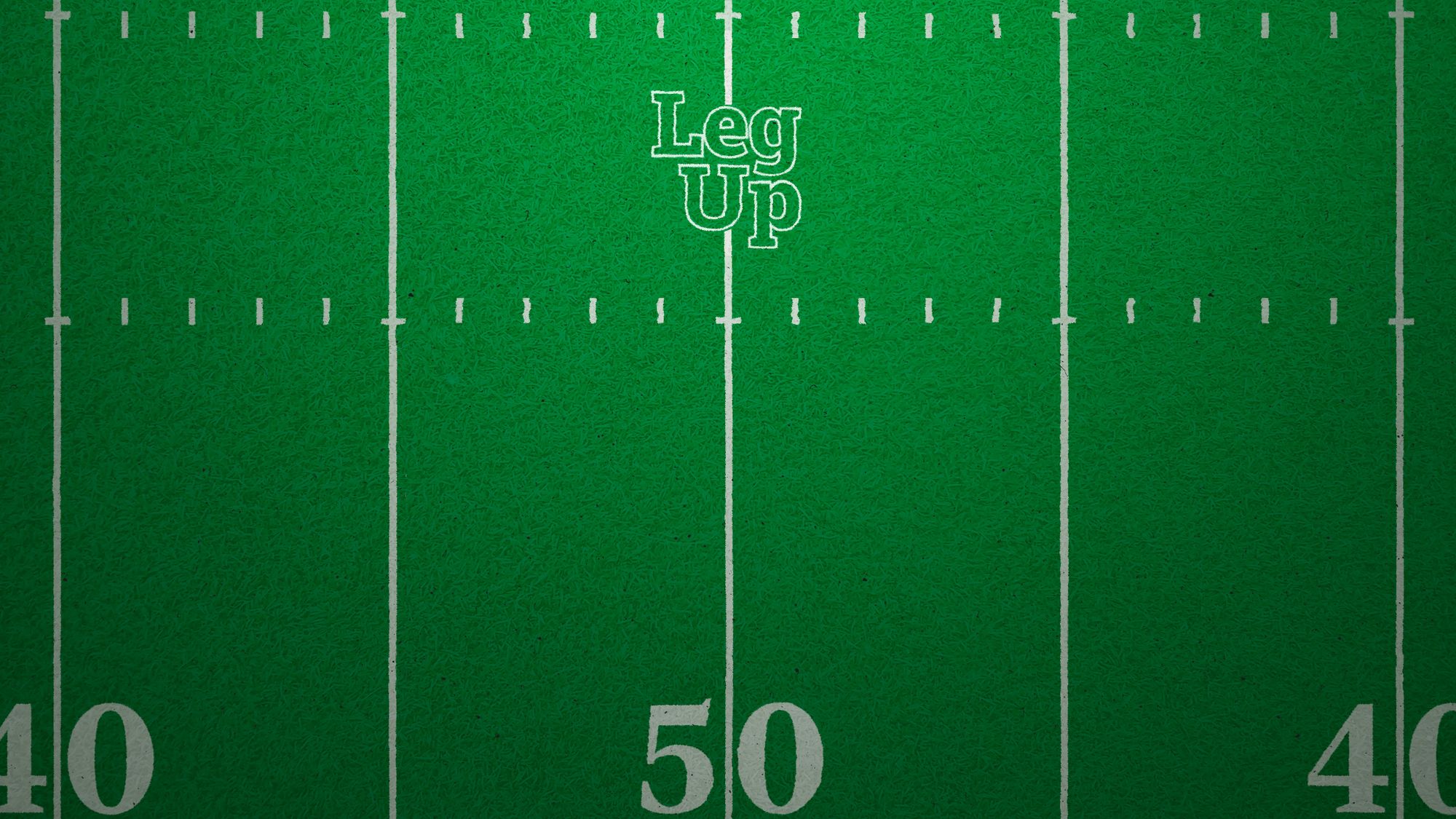
Full Newsletter Archive

Details on $50 Underdog Credit, 40% off Spike Week, Discord Access, Premium Podcast Feed



